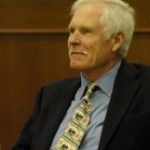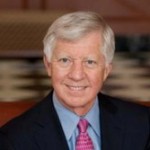Feb25
Ted Turner on Visionary Leadership
Point: Ted Turner’s tips for seeing over the horizon
Story: Many leaders are described as “visionary” — I’m always curious as to how they got that way. Is it something they’re born with, or something we can we all learn? I had a chance to participate in a Silicon Flatirons Q&A with media mogul Ted Turner as we probed this question with Ted.
Is it something they’re born with, or something we can we all learn? I had a chance to participate in a Silicon Flatirons Q&A with media mogul Ted Turner as we probed this question with Ted.
Before CNN, people didn’t think that a 24-hour-a-day news channel was viable. How did Ted prove them wrong? “It helps to see over the horizon,” Ted said. ‘Most people can’t do it, but I think your brain is like a muscle. And just like any other muscle, you can use it and your brain will improve.”
Ted elaborated: “I have a 128 IQ, but 140 is genius. I was in the 97th percentile, so that means 3 percent of people were smarter than me. I knew I was going to have to work hard if I wanted to accomplish something in life. So I read a lot — classics, warfare, Alexander the Great — I used my brain all the time. Everything I did was education. Others just shot the breeze, wasted time — nothing wrong with that, but you can’t get to the top doing that.”
Ted’s answer points to a combination of aptitude and hard work. (I think it’s interesting that Ted thought being in the 97th percentile meant he’d have to work hard if he wanted to accomplish something — it reminded me of Andy Grove’s “only the paranoid survive” philosophy.)
What did Ted see over the horizon? As Ted described it, the idea for CNN was born of his own desire to stay on top of the news but, as a busy executive, not having time to watch the news during the two times a day it was on during the 1970s. “I knew I was gambling with CNN, but I knew it would work,” Ted said. “At the time, the news came on at 6:30 and again at 11pm. I never saw the news — it was inconvenient. I knew that having news on 24 hours a day so you could check in anytime was something that people would want.”
Beyond CNN, Ted was also working to build a multichannel universe. CNN fit into this universe perfectly. In the 1970s, three broadcast networks — ABC, NBC and CBS — controlled the programming people could see. For example, sports games across the country were televized, but they couldn’t be seen outside the local area because the broadcasters had a monopoly. “The broadcasters had carved up the games,” Ted said, dividing the NFL, AFL and Monday Night Football between them. “Everyone paid the same prices and made the same profit. All three networks were happy, but I wasn’t happy” — customers weren’t being served, and incumbents had no incentive to change.
This is where Ted’s reading and habit of learning came into play again. “It was in early 1975 that I saw an article about communications satellites in Broadcasting magazine,” Ted recalled. Reading the article, Ted realized that he could use one satellite “antenna” in space to cover all of North America. He’d found a way to compete with the established networks.
There’d be more hard work along the way — “We sweated payroll for ten years,” Ted said — but Ted relished the challenges. “The way to lead is with infectious enthusiasm, get everyone enthusiastic about what we’re doing.”
Action:
* Fit your current strategy into the larger picture: Ted’s vision for CNN was part of his overall goal to build a multi-channel universe
* Lead with infectious enthusiasm
Sources:
Silicon Flatirons Q&A November 13, 2009
Call Me Ted, by Ted Turner












